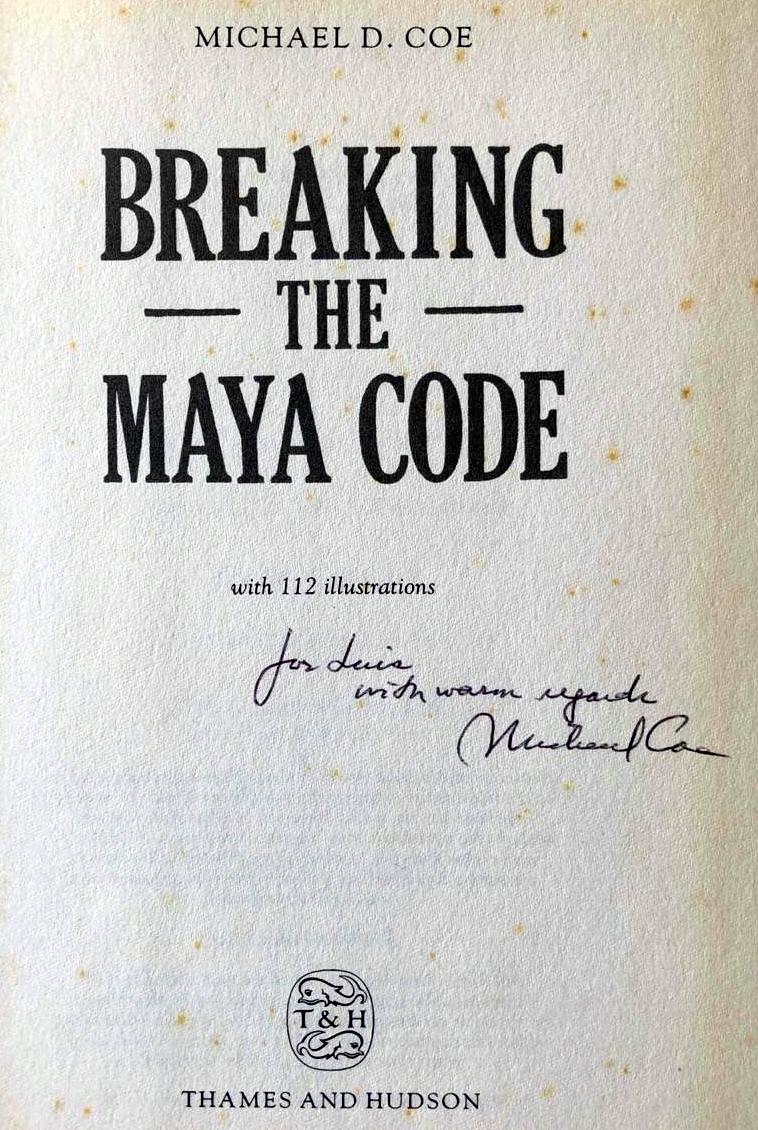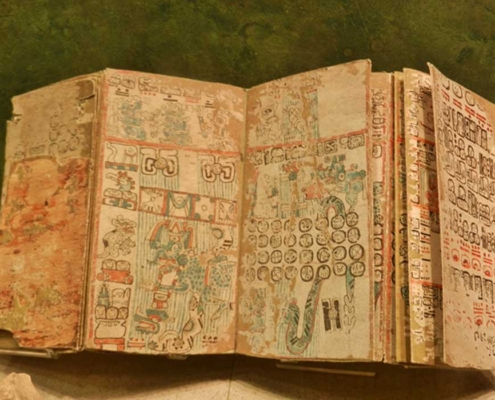I chose to assemble this thorough information about Mayan symbols for a common phrase found on Mayan ruins and other signage. This is due in part to the fact that the Mayan society created a sophisticated language.
Most visitors to Guatemala, including those who visit Tikal, only get a glimpse of how the Maya created this complicated code for their writings in glyphs.
The book “Cracking the Maya Code” by Michael D. Coe, while a landmark contribution to understanding Maya writing,
Here’s a breakdown:
- Focus: The book primarily focuses on the deciphering process of the Maya writing system, explaining the historical context, challenges, and breakthroughs in unlocking the meaning of the glyphs.
- Limited Scope: While the book touches upon various aspects of Maya life and culture, its main objective isn’t to delve into specific details about their medical practices or healing traditions.
“Cracking the Maya Code” refers to the ongoing process of deciphering the ancient writing system of the Maya civilization. This complex script, consisting of hundreds of glyphs, was used to record a variety of information, including history, religion, astronomy, and daily life.
For centuries, the Maya script remained a mystery, baffling scholars and archaeologists. However, in the mid-20th century, a series of breakthroughs began to crack the code. Pioneering scholars like Yuri Knorozov, Tatiana Proskouriakoff, and Heinrich Berlin made significant contributions to understanding the phonetic and symbolic nature of the glyphs.
Their work revealed that the Maya writing system was a combination of logograms (representing entire words) and syllabograms (representing sounds). This dual system, similar to the one used in ancient Egyptian hieroglyphs, allowed the Maya to express a wide range of ideas with remarkable accuracy.
The deciphering of the Maya code has had a profound impact on our understanding of this ancient civilization. It has shed light on their complex political systems, sophisticated calendar and astronomical knowledge, and rich mythology.
Here are some key aspects of the Maya writing system and its decipherment:
- Logograms: These glyphs represent entire words, such as the names of deities, places, and rulers.
- Syllabograms: These glyphs represent individual sounds or syllables, allowing for the writing of words not represented by logograms.
- Determinatives: These glyphs provide additional context to the meaning of other glyphs, similar to punctuation marks in modern languages.
- Challenges: The decipherment process was slow and painstaking, due to the fragmentary nature of the surviving inscriptions and the lack of a complete bilingual text (a text written in both Maya and a known language).
Despite the ongoing challenges, significant progress has been made in deciphering the Maya code. This ongoing effort continues to reveal new insights into the lives and culture of this remarkable civilization.
Cracking the Maya Code. The Dresden Codex is a fascinating link between the Mayan writing system and our understanding of their culture and history. It’s one of the four surviving Maya codices,折叠本 (zhé dié běn) (folding books) containing information about various aspects of Mayan life. Here’s how they are connected:
The Dresden Codex:
- Created around 1200-1250 AD in the Yucatan Peninsula.
- Considered the most elaborate and best preserved of the codices.
- Features intricate illustrations and hundreds of glyphs, covering diverse topics like:
- Astronomy: Detailed tables for tracking celestial bodies like Venus and the moon.
- Rituals: Depictions of ceremonies and offerings to various deities.
- Numerology: Calculations and symbolic use of numbers.
- Calendrical systems: Long Count calendar and 260-day calendar.
Connection to the Mayan Writing System:
- The Dresden Codex serves as a primary source for understanding the Maya writing system.
- Scholars utilize the information within the codex to:
- Decipher the meaning of individual glyphs and their combinations.
- Gain insights into the grammatical structure of the Mayan language.
- Understand the complex symbolism and interconnectedness of various elements within the writing system.
Examples:
- The astronomical tables in the Dresden Codex showcase the use of numerals and calendrical glyphs.
- Depictions of deities and rituals often include their corresponding names written in glyphs.
- The codex also features explanatory glyphs providing context to the illustrations and rituals depicted.
Overall, the Dresden Codex plays a crucial role in deciphering the Mayan code and unlocking the secrets of their rich culture and complex writing system. By studying the content and analyzing the glyphs within the codex, scholars gain valuable insights into the world of the ancient Maya.
Here’s a breakdown of the difference between the Mayan Codex and Mayan glyph meaning:
Mayan Codex:
- Refers to foldable books written by the Maya civilization using their unique writing system, Maya hieroglyphs.
- These codices served as record-keeping tools, containing information about various aspects of Maya life, including:
- History: Recordings of significant events, rulers, and dynasties.
- Astronomy: Astronomical observations, calendars, and rituals.
- Religion: Myths, deities, and religious practices.
- Mathematics: Calculations, astronomical formulas, and number systems.
- Only four codices have survived from the Spanish conquest, considered invaluable sources of information about the Maya.
- Examples: Dresden Codex, Madrid Codex, Paris Codex, and the Maya Codex of Mexico.
Mayan glyph meaning:
- Refers to the individual meaning of a specific symbol used in the Maya writing system.
- Each glyph can have:
- Multiple meanings depending on the context.
- Logographic meaning, represents entire words or concepts.
- Syllabographic meaning, representing syllables.
- Understanding the meaning of a single glyph requires careful analysis considering:
- Surrounding glyphs within the text.
- Position within the sentence or inscription.
- Iconographic elements within the glyph itself.
In summary:
- Mayan Codex is a physical object containing writing in the form of glyphs.
- Mayan glyph meaning refers to the interpretation of individual symbols within the Mayan writing system.
They are interconnected:
- The codices are written using glyphs.
- Understanding glyph meanings is crucial for deciphering the content of the codices.
Breaking The Ancient Maya Code | Archeology | Timeline
But in 1965, Russian linguist Yuri Knorosov cracked the phonetic code of Mayan hieroglyphic writing in the confinements of his bustling Leningrad study.




 Ethical Fashion Guatemala
Ethical Fashion Guatemala Ethical Fashion Guatemala
Ethical Fashion Guatemala